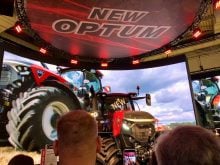Farmers should keep in mind the acres they work when trying to decide what equipment they need.
A sharp pencil and an idea of the average cost for Canadian producers can ensure a machinery investment is made wisely.
With farm equipment, producers can tie up a lot of what might otherwise be operating capital in unused assets, said Ted Nilbourg, a farm business management specialist with Alberta Agriculture.
“It’s a balancing act between unused
capacity and timeliness of field operations,” he said.
Read Also

Agritechnica Day 2: The future of tractor power, building quicker crop apps and large farms and tech
Agritechnica Day 2: The future of tractor power, building quicker crop apps with Syngenta and large farms and tech
“Then you need to look at commodity prices and, just for good measure, throw the weather into the decision-making mix.”
Nilbourg said these variables indicate benchmarking the investment level is a good practice.
Ken Rosaasen of the University of Saskatchewan agreed.
“You can’t always make the decision you’d like to because you need more capacity or a newer machine at times when it often isn’t convenient for your operation. That’s why having a relative measure of what is a common figure in your industry helps when it comes time to make those investments.”
Rosaasen said too many producers used to believe each must own a full line of equipment to farm.
“There are alternatives: sharing specialized or limited use equipment. Custom operators, too, have a place. Knowing how much you should have invested in equipment allows you to go out and make a decision that may be contrary to the average operation, but it will be an informed decision,” he said.
Business advisers say it also is useful for establishing financing for a major capital purchase.
Nilbourg analyzed Statistics Canada data from 1998 to 2004 to derive some benchmark measurements for the Canadian industry.
In Alberta, he found grain farmers have 16 to 18 percent of their total farm investment in machinery, or about $11,000 per quarter section of land.
As a percentage of their net operating income, before machinery depreciation, the figure varied from a low of 8.5 percent of net sales to a high of 23.3 percent.
Another way of looking at the operational costs of machinery is the investment ratio for gross revenue.
Machinery investment ratios are calculated by dividing the market value of the equipment by the number of acres and again dividing by the long-term gross revenue per acre.
Nilbourg’s analysis of Alberta producers created a long-term average ratio of 1.95. This means that producers have $1.95 invested in equipment for each $1 of average, annual gross returns from their operations.
If a management depreciation rate of 10 percent is used to calculate depreciation, versus a capital cost allowance model, producers require between 17 and 23 percent of their gross revenue to cover their machinery costs over the long term.
“This is the figure that contribution margin has to cover.”
Nilbourg said livestock operations have different machinery investment ratios.
He found the higher livestock receipts and lesser equipment needs resulted in a ratio of betweem 0.79 and 1.14 with an average of 0.97.
“Their long-term average is 97 cents invested in equipment for each dollar of annual gross revenue,” he said.
Nilbourg said producers who find their ratios out of the average range should consider the cause.
Producers with high ratios could consider renting additional land to improve their equipment efficiency or else downsize or sell underused machinery or buy the services of custom operators, he added.














